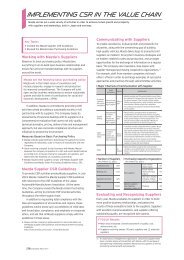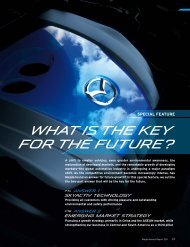Download full text in PDF format. - Mazda
Download full text in PDF format. - Mazda
Download full text in PDF format. - Mazda
Create successful ePaper yourself
Turn your PDF publications into a flip-book with our unique Google optimized e-Paper software.
Activities as an automobile manufacturer<br />
Environmental Management/Environmental Profection Activites<br />
Sav<strong>in</strong>g energy <strong>in</strong> logistics<br />
<strong>Mazda</strong> is work<strong>in</strong>g to accurately monitor CO2 emissions <strong>in</strong> logistics and<br />
distribution, and reduc<strong>in</strong>g them by improved efficiencies, switch<strong>in</strong>g to<br />
alternate transport modes and other measures. Total CO2 emissions <strong>in</strong><br />
the logistics sector reached 5,631 tons <strong>in</strong> fiscal 2004.<br />
Reduced <strong>in</strong>-house deliveries<br />
<strong>Mazda</strong> began <strong>full</strong>-fledged <strong>in</strong>troduction of the <strong>Mazda</strong> Milk-Run System<br />
(MRS) <strong>in</strong> fiscal 2003, and has been steadily decreas<strong>in</strong>g the number of<br />
trucks used for parts transport. Improvements to the MRS system<br />
reduced CO2 emissions <strong>in</strong> fiscal 2004 by 2,681 tons. Additional<br />
improvements <strong>in</strong> load<strong>in</strong>g efficiency and shared transport of f<strong>in</strong>ished<br />
vehicles reduced emissions by an additional 143 tons.<br />
Utilization of sea transport<br />
Nakanoseki Port<br />
Tak<strong>in</strong>g advantage of its location on the Seto Inland Sea, <strong>Mazda</strong> began<br />
its modal shift toward sea transport quite some time ago. Today about<br />
80% of all vehicles are transported by sea, and 92% of all vehicles<br />
bound for the domestic market. In fiscal 2004 we expanded the feeder<br />
routes throughout Asia and took other measures to shorten transport<br />
distances for export parts, as well as m<strong>in</strong>imiz<strong>in</strong>g truck use to ports,<br />
reduc<strong>in</strong>g CO2 emissions by 2,807 tons.<br />
Logistics system diagram<br />
Parts manufacturer, etc.<br />
<strong>Mazda</strong><br />
Products (vehicles) for domestic market (92% by sea)<br />
Manufacturer<br />
Rail<br />
Between or with<strong>in</strong> plants<br />
F<strong>in</strong>ished vehicles<br />
F<strong>in</strong>ished vehicle pool<br />
Pure car<br />
carrier<br />
Ship<br />
Distribution center<br />
Depot<br />
Dealership<br />
Dealer<br />
Domestic<br />
customer<br />
Overseas<br />
customer<br />
Manufacturer<br />
Ship<br />
Efficiency improvement<br />
of transportation<br />
KD distribution<br />
KD pool<br />
Ship<br />
Local port<br />
Overseas plant<br />
Manufacturer<br />
Plant<br />
Plant<br />
Manufacturer<br />
Base<br />
Us<strong>in</strong>g the MRS (<strong>Mazda</strong> Milk-Run System)<br />
Service parts distribution<br />
Parts Center<br />
Promoto use of<br />
small electric vehicles<br />
Ship<br />
Parts dealership<br />
Distributor<br />
Dealership<br />
Dealership<br />
Domestic<br />
customer<br />
Overseas<br />
customer<br />
Improved efficiency and management <strong>in</strong> parts transport<br />
<strong>Mazda</strong> is steadily switch<strong>in</strong>g to electric forklifts for parts procurement<br />
and <strong>in</strong>-plant transport. At the end of FY 2004 we operated 166 electric<br />
forklifts, represent<strong>in</strong>g 24% of the total. From FY 2003 we have also<br />
begun <strong>in</strong>troduc<strong>in</strong>g tow<strong>in</strong>g tractors <strong>in</strong>stead of forklifts at parts centers<br />
handl<strong>in</strong>g customer parts and other distribution operations, further<br />
slash<strong>in</strong>g CO2 emissions.<br />
Glossary: 3<br />
Glossary 4<br />
Modal shift<br />
MRS (<strong>Mazda</strong> Milk-Run System)<br />
In an effort to reduce the amount of CO2 emissions<br />
from logistics, we are shift<strong>in</strong>g the mode of<br />
transportation to large-volume transport methods<br />
such as ships and tra<strong>in</strong>s, which have lower<br />
The term milk-run is used to refer to a s<strong>in</strong>gle truck which<br />
cycles around multiple suppliers collect<strong>in</strong>g freight. The<br />
name is derived from the milk runs of farmers collect<strong>in</strong>g<br />
milk from their dairy cows throughout the pasture.<br />
Social & Environmental Report 2005



![Color[964KB] - Mazda](https://img.yumpu.com/48532826/1/190x143/color964kb-mazda.jpg?quality=85)
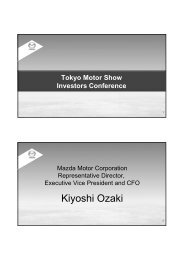
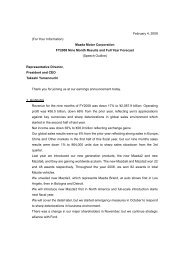

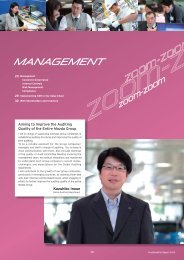

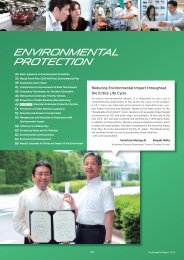
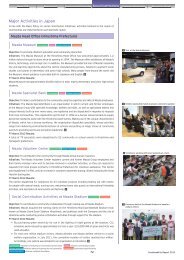
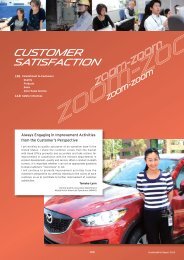


![Board of Directors [388k] - Mazda](https://img.yumpu.com/24394827/1/190x248/board-of-directors-388k-mazda.jpg?quality=85)
